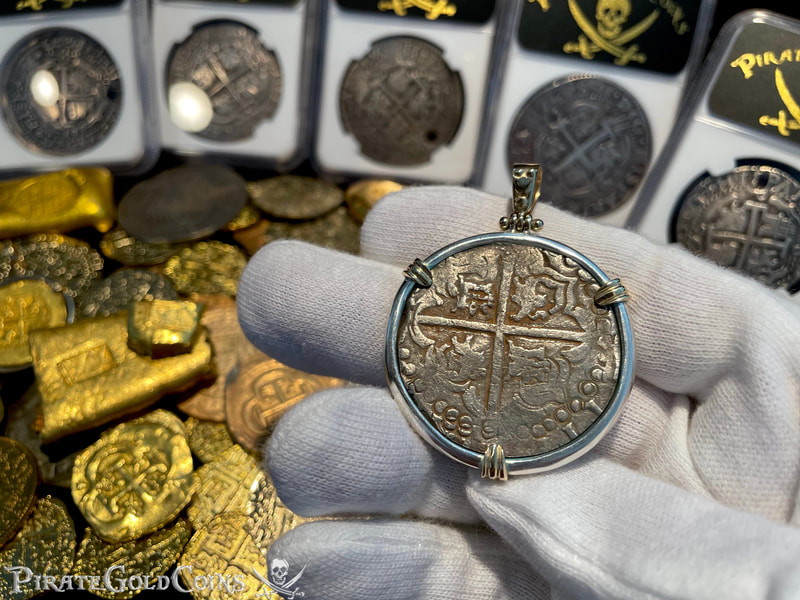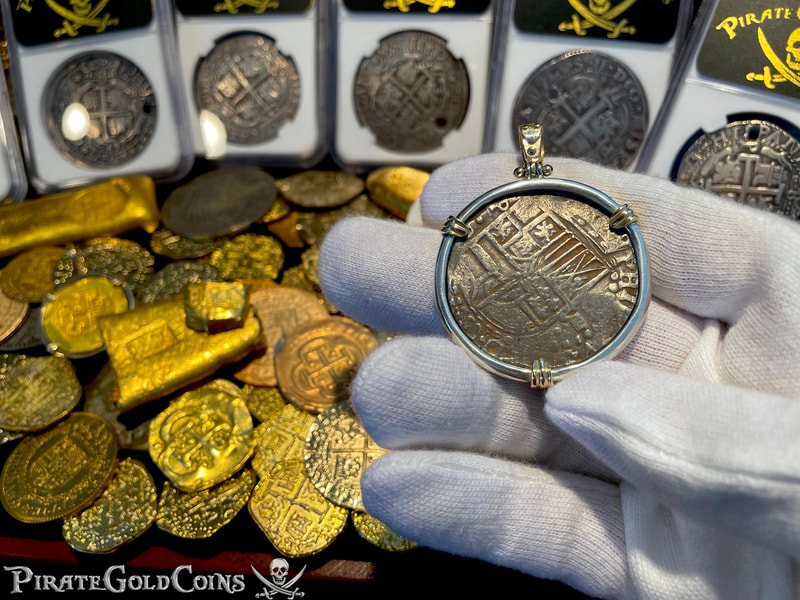Bolivia 8 Reales "Panama Hoard 1629" 14kt Bezel
Potosi, Bolivia, cob 8 reales, Philip IV, assayer P (1620s), quadrants of cross transposed, ex-Panama hoard (ca. 1629), mounted cross-side out in thick silver bezel with 14K gold prongs and shackle bail. 38.45 grams total. VF coin, bold but slightly off-center cross with some weak areas (turned 90 degrees clockwise relative to the mounting), good full shield (slightly doubled) with much orange sediment in crevices, sturdy round mounting (coin edge probably lightly shaved to fit). From the ca.-1629 "Panama hoard," with photo-certificate.
In the early 1990s the numismatic market began to hear about a massive find of 4,500 early Potosí cobs (practically all 8 and 4 reales) in fabulous condition—in-fact, totally un-corroded but with tell tale orange clay on what were otherwise Mint State (or nearly so) surfaces. Soon this hoard took on many different names as the stories emerged: “Panama hoard,” “Camino Real Trail hoard,” and, curiously, “Mule Train hoard” (based on a rumor that the hoard was lost when a mule that was carrying the treasure fell over a cliff). The most believable story we have heard (albeit the least romantic) is that the hoard was found stashed in the wall of a house that was torn down in 1977. The political atmosphere under General Noriega kept most of the coins in hiding until the 1990s. The latest date on the coins in this hoard is 1629, but in order to allow enough time for the coins to travel from Potosí to Porto Bello the date of the hoard is sometimes given as 1630.
In the early 1990s the numismatic market began to hear about a massive find of 4,500 early Potosí cobs (practically all 8 and 4 reales) in fabulous condition—in-fact, totally un-corroded but with tell tale orange clay on what were otherwise Mint State (or nearly so) surfaces. Soon this hoard took on many different names as the stories emerged: “Panama hoard,” “Camino Real Trail hoard,” and, curiously, “Mule Train hoard” (based on a rumor that the hoard was lost when a mule that was carrying the treasure fell over a cliff). The most believable story we have heard (albeit the least romantic) is that the hoard was found stashed in the wall of a house that was torn down in 1977. The political atmosphere under General Noriega kept most of the coins in hiding until the 1990s. The latest date on the coins in this hoard is 1629, but in order to allow enough time for the coins to travel from Potosí to Porto Bello the date of the hoard is sometimes given as 1630.













